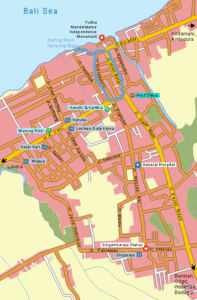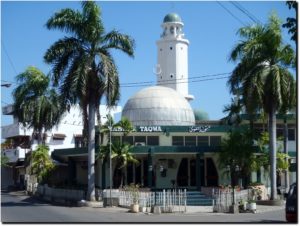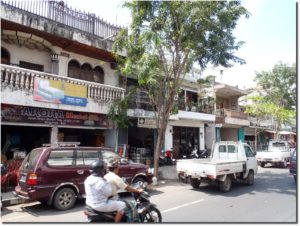
A few posts ago, I mentioned that I was going to get some needed exercise while exploring the city that I’ve called home for most of the past 23 years. I’ve been waiting to get over a bout of pneumonia, but it’s been a long time coming – getting well that is – so I’ve decided that the best way to speed my recovery at this point is to just get out and do some walking. One thing that I’ve discovered while planning my walking tour of the city on a map is just how big Singaraja actually is. That little discovery has surprised me, I think, just because I’ve taken the city for granted. It’s a fairly common thing for people to fall into comfortable routines, and we miss all of the wonder and the changes around us. So, if I really want to do right by Singaraja, I’m going to be doing a lot of walking over the coming months.
I’ve been thinking about how best to do my little walking tour, and I finally decided that the best place to start is from home. It makes a lot of sense geographically because we are right at the edge of the world – so to speak – because three meters in front of our house is the Bali Sea and that’s where Singaraja ends. So, I’m starting out from home and making little forays farther and farther out from the house.

My first walk is just a little stroll out of Kampung Bugis past Masjid Taqwa down Jalan Diponegoro (Singaraja’s central business district – that’s probably too grand a title for Jalan Diponegoro, but I like it so why not) then over to Jalan A. Yani and back down Jalan Imam Bonjol to the harbor and home again. The route is traced out on the map of Singaraja for readers who want to locate the areas that I’m writing about on a map. Jalan Diponegoro is the central shopping area and the city’s main traditional market is located right in the middle of the street although it can be a bit difficult to discover because the entrance is just a small opening on Jalan Diponegoro – the actual market is between Diponegoro and Jalan Imam Bonjol. The market has fresh fruits and vegetables, meat, spices, clothes and a variety of other dry goods. Really, I don’t find it all that interesting, although it does seem to attract a number of tourists who want to see a traditional market.
The street also has electronic stores (I buy all my electronic equipment there), a few small restaurants, shoe stores, a few book stores (including a new one that I just discovered on this walk), a pharmacy, a few doctor’s offices, some fishing equipment shops, a small mini-market, two or three clothing stores, the main branch of BII (Bank Internasional Indonesia), a few hair saloons, a few gold shops, and an assortment of shops selling household goods. The street is almost always crowded with traffic due to the relatively new practice of allowing double parking which causes traffic to back up during the busy shopping hours of the day. I’ll get back to discussing Jalan A. Yani in another post.

Jalan Imam Bonjol is another busy street just to the east of Jalan Diponegoro. It is filled with shops selling a variety of things, such as household goods, furniture, car and motorbike parts, gold jewelry, and children’s toys. This street also has an entrance to the main market and a new mini-market. While Jalan Diponegoro is a one way street running north, Jalan Imam Bonjol is a one-way street running south. Most of the buildings are two stories with a shop on the ground floor and a residence on the second story. Running off of Jalan Imam Bonjol to the east and west are several small streets called gangs in Bahasa Indonesia.





